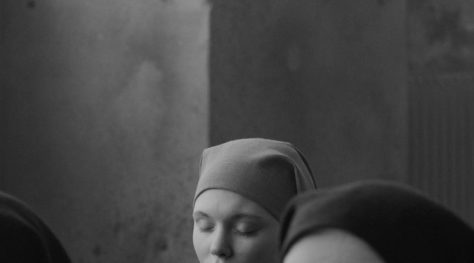The most impressive aspect of Ida, the 2014 EFA champion and Polish Golden Globe nominee from director Pawel Pawlikowski, is without a doubt the stark visual staging and meticulous shot composition. Unlike Andreas Prochaska’s The Dark Valley — another awards season foreign language contender — the visual beauty of Ida meshes seamlessly with the story rather than overwhelming it. Newcomer Agata Trzebuchowska plays the young nun-in-training of the film’s title, and her forays from the convent into what some might call “the real world” provide the framework for Ida.
Ida was essentially born into her role in the convent, abandoned as a child and only now old enough to venture out. She’s nearly ready to take her final vows and become a full-fledged nun (“It’s morphin’ time!”) but before she does, she leaves the convent to track down her estranged aunt and get a little taste of the outside world. It’s not long before this Catholic nun discovers a truth about her past: she’s Jewish. This is only the first of many threats to Ida’s identity, one focused squarely in the past and in the present, and the revelation of the love and struggle and verve of the world outside the convent shakes up Ida’s future.
But first: the visuals. The shot-by-shot continuity extends past your normal same-time-same-place concerns into a visual motif that grounds Ida in a unique way. This is taking the long way around the barn to say that Pawlikowski finds a balance from scene to scene by subtly mirroring everything that’s come before. One of these motifs, for instance, places the subject at the very bottom of the shot while giving a sense of the air above them:

That’s Ida as she cries in church. She doesn’t look altogether different, lighting aside, while asleep in the car:

The first time this kind of shot is employed, it takes a second to get used to. Is the camera going to pan down? Is something going to enter the frame above Ida’s head? It would seem as if there’d be little reason to leave so much space at the top, but then the theme is reiterated again and again. It’s not so strange the second time around, and by the third time it’s clear that the “reasons” — if we must slot this stuff into such overly logical categories — are numerous. Sometimes it makes Ida seem small, usually when she’s feeling small. She’s minimized in that shot in the church because she no longer feels at home there, and minimized in the car as it traverses places she’s never been because the world makes her feel so small. That comes up again — the feeling-small-in-the-world thing — and provides an example of a wider, more comprehensive shot within the same technique.

We get the barrenness of the field and the dark, thick inscrutability of the forest they’re headed toward, but most of all we get the sense that these are people moving through a vast landscape. Most of the shot is just gray sky. There’s a lot more to look at here:

…but still, the sense remains that these people are just a part of the whole, and a small part at that. For much of Ida people are caught in this in-betweenness: should they want to sacrifice themselves to the larger world, or should they want to break out and be larger themselves? Ida and her aunt are able to deal with this — or not deal with this — in various ways throughout the film.
This isn’t to say that the entire movie is shot like this. Pawlikowski can find the depth and beauty in seemingly anything:

And, again, that beauty isn’t just visual. There’s a scene where Ida cracks up laughing to herself while eating soup with her fellow sisters after she returns to the convent. The sisters glare at her, and it’s clear that she’s remembered something from that musical outer world and smuggled it back into the convent with her. So the main difference from other beatifully-shot foreign films of this past year such as the aforementioned Dark Valley or Lisandro Alonso’s Jauja is that Ida actually has a story as compelling as the visuals. Be on the lookout for Ida throughout awards season, and expect it to take home more than a few stateside trophies.


2 thoughts on “Ida (2014)”